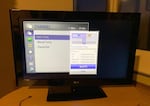
TV viewers who use an over-the-air antenna in the Pacific Northwest should find and run the rescan menu command.
Tom Banse / Northwest News Network
Are you missing your favorite TV channel? Some over-the-air signals in Western Washington, greater Portland and the Tri-Cities region switched frequencies this month. Fortunately, it should be easy to get channels back if they disappeared from your screen.
This issue only affects viewers who watch TV for free using an antenna. No worries if you're a cable TV or satellite subscriber. What's happening is the federal government required local TV stations to pack their transmissions closer together to create more capacity for other users of the airwaves.
"We could free up some space, which we sorely need for wireless broadband services -- for wireless devices like your mobile telephones, iPads, other mobile tablets, and things like that all require a lot of bandwidth," explained Jean Kiddoo, an executive at the Federal Communications Commission. "More and more consumers are wanting more and more speed and more and more capacity. So that's what we did."
Kiddoo said there is an uncomplicated fix for antenna-TV viewers who are seeing a blue or blank screen all of a sudden because of the channel "repacking" process. She recommended consumers run the scan or "auto tune" command on their TVs or digital converter boxes. That will retrain a TV to find local broadcast channels at their new digital frequencies. The channel number actually shown on screen -- the old, familiar broadcast brands -- will not change.
The frequency switchovers happened in the middle of the night last weekend in Seattle, and earlier this month in Portland. In Portland, KATU 2, KOIN 6, KNMT 24 and a couple of low-power independent channels moved to new spots on the airwaves. In Seattle, KOMO 4, KING 5, KIRO 7, KZJO 22, KUNS 51 and a trio of religious stations were affected. In Bellingham, KVOS 12 changed its frequency. In the Tri-Cities region, KVEW 42 and KTNW (PBS) 31 are affected. The PBS station will switch to a new transmitter and antenna with a stronger signal on Nov. 14.
Whether or not your favorite local TV stations moved to new homes this month, the FCC said it’s a good idea for over-the-air TV viewers to periodically rescan.
"If you haven’t rescanned a TV in a while and you're using an antenna, chances are there are more stations on it than you knew you had because new stations are coming on line," Kiddoo observed.
Kiddoo said the broadcast stations that had to change frequencies were compensated for their trouble. The FCC will reimburse them for the costs of moving, including for the expense of a new transmitter or tower in some cases. There is a budget for that because a 2017 auction of the airwaves to be freed up generated more than $19 billion in winning bids from wireless companies.
The number of viewers who watch local channels using a rooftop or indoor antenna varies from area to area. Earlier this year, TV ratings provider Nielsen estimated anywhere from 5 to 25 percent of metropolitan households have at least one TV hooked to an antenna. In the Portland market it was 15.6 percent and the Seattle market measured at 8.5 percent.
"The number is rising pretty quickly as folks are cutting the cord and want to be able to continue to get local news, local weather, emergency alerts and local programming, which they can do with a relatively inexpensive antenna for free over the air," Kiddoo told public radio.

9(MDAzMTY3NDM2MDEyMzYyODg4ODVhMjM5Ng001))